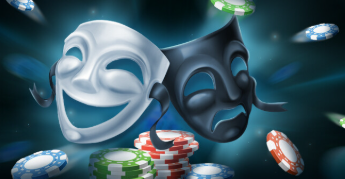Bluffing is the art of telling a believable story.
In poker, it’s not that easy to get a really strong hand. That’s why sometimes you have to bluff. Without bluffing, the game wouldn’t be as deep and exciting.
But you need to know how to bluff well. It’s not enough to bet a lot when you have junk cards in your hand. You need to do it at the right time and against the right opponents.
Before betting, take a look at the hand from the outside: would you really play this way with a strong hand at every stage, starting with the preflop? Nothing makes your opponent want to call like a line of play that doesn’t make sense.

It is important to remember that bluffing is not just for show, but a strategic decision. The decision to risk your stack should only be made after careful consideration and thoughtful analysis.
There are several rules that will help you make your bluffs more effective.
The art of bluffing in poker: how to use it to your best advantage
1.In a game of chance such as poker, bluffing is a powerful tool that can turn the tide in your favor. However, using it effectively requires not only the ability to deceive your opponents, but also strategy, tactics, and an understanding of the context. Here are some key principles to help you use this tool correctly in poker.
2.Choose the right opponent. Never bluff against a “caller” — someone who will call any pair or draw to the showdown. Bluff against players who are likely to fold. Try to avoid aggressive players who often respond to bets with raises.
3.Consider your image at the table. If you are perceived as a tight player, your bluffs will work more often, as your opponents will believe that you have strong cards. Conversely, if you have been caught bluffing several times, it is clearly worth slowing down.
4.Bluff when you have equity. That is, with hands that have the potential to improve. These can be flush draws, straight draws, gutshot draws, overcards, and even backdoor combinations. Having even a small chance of catching a lucky card is better than having no chance at all. And if the card comes, you can win a huge pot.
5.Use “scary cards.” Let’s say you opened from UTG with KQ and your opponent called on the BB. On the flop of 692, he called your continuation bet, and an ace came on the turn. This is a great card to continue betting with – it strengthens your range well, while the big blind’s range looks weaker here… With a 6, your opponent will be afraid that you have an ace and that you will make another big bet on the river.
6.Choose the size of your bluff. If your opponent clearly hit a pair, bet big when a dangerous card comes out. This will make it much harder for them to call. In deep stacks, you also need to bluff with a larger bet. But there are situations where, on the contrary, it is not worth betting big on a bluff, as a small bet will have the same effect at a lower cost.
7.Consider the size of the stack. Be careful when bluffing against players with a short stack — you can often get an all-in in response…
8.Don’t overdo it. Bluff infrequently and wisely. If your opponents see that you bluff too much, they will be inclined to call you more often.
One of the most important aspects is the ability to read your opponents. Pay attention to their playing style, reactions to bets, and their position at the table. Careful analysis of these details will help you determine when an opponent is ready to call or, conversely, is inclined to fold. Bluffing tactics are more likely to succeed when you choose the right moment. Observing the situation, analyzing the current state of the table, and understanding the dynamics of the game will help you determine when a bluff can be most effective.